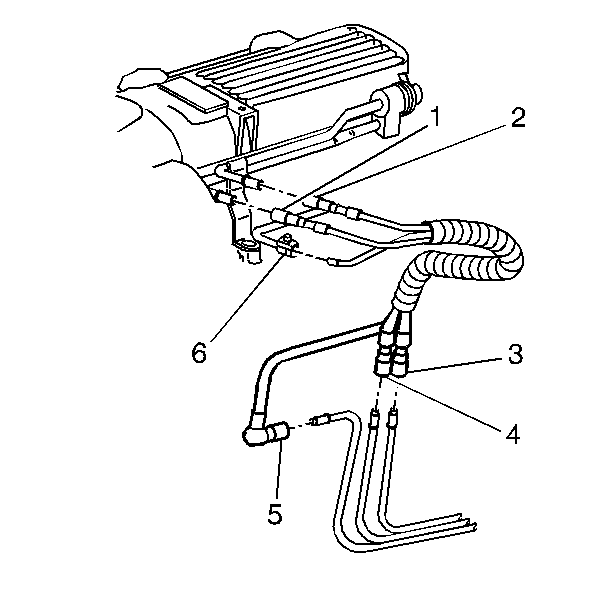Removal Procedure
Caution: In order to Reduce the Risk of Fire and Personal Injury:
• If nylon fuel pipes are nicked, scratched or damaged during installation,
Do Not attempt to repair the sections of the nylon fuel pipes. Replace them. • When installing new fuel pipes, Do Not hammer directly on the
fuel harness body clips as it may damage the nylon pipes resulting in a possible
fuel leak. • Always cover nylon vapor pipes with a wet towel before using a
torch near them. Also, never expose the vehicle to temperatures higher than
115°C (239°F) for more than one hour, or more than 90°C (194°F)
for any extended period. • Before connecting fuel pipe fittings, always apply a few drops
of clean engine oil to the male pipe ends. This will ensure proper reconnection
and prevent a possible fuel leak. (During normal operation, the O-rings located
in the female connector will swell and may prevent proper reconnection if
not lubricated.)
Notice: Do not attempt to straighten any kinked nylon fuel lines. Replace any kinked nylon fuel feed or return pipes in order to prevent damage to the vehicle.
Notice: Replace the EVAP pipes and hoses with the original equipment or parts that meet the GM specifications for those parts. The replacement EVAP pipe must have the same type of fittings as the original pipe in order to ensure the integrity of the connection. When replacing EVAP hoses, use only reinforced fuel-resistant hose identified with the word Fluoroelastomer or GM 6163-M on the hose. The inside hose diameter must match the outside pipe diameter. Do not use rubber hose within 100 mm (4 in) of any part of the exhaust system or within 254 mm (10 in) of the catalytic converter.
Notice: Cap the fittings and plug the holes when servicing the fuel system in order to prevent dirt and other contaminants from entering the open pipes and passages.
Important: Always maintain cleanliness when servicing fuel system components.
- Relieve the fuel system pressure. Refer to the Fuel Pressure Relief .
- Drain the fuel tank. Refer to Fuel Tank Draining .
- Clean all the engine compartment connecting fuel pipe connections and the surrounding areas before disconnecting in order to avoid possible contamination of the fuel system.
- Disconnect the fuel feed pipe (1) at the engine. Refer to Metal Collar Quick Connect Fitting Service .
- Disconnect the fuel return pipe (2) at the engine.
- Disconnect the EVAP pipe (6) at the engine.
- Raise the vehicle. Go to Lifting and Jacking the Vehicle in general information.
- Disconnect the EVAP pipe (5) at the chassis fuel and EVAP pipes.
- Disconnect the fuel feed pipe (4) at the chassis fuel and EVAP pipes.
- Disconnect the fuel return pipe (3) at the chassis fuel and EVAP pipes.
- Remove the fuel feed, return, and EVAP pipes.

Installation Procedure
Important:
• Always re-attach the fuel lines and fuel filter with all original
type fasteners and hardware. • If fuel line bundle attaching hardware is damaged or broken replace
it.
- Install the fuel feed, return, and EVAP pipes.
- Connect the fuel feed pipe (4) at the chassis fuel and EVAP pipes.
- Connect the fuel return pipe (3) at the chassis fuel and EVAP pipes.
- Connect the EVAP pipe (5) at the chassis fuel and EVAP pipes.
- Lower the vehicle.
- Connect the fuel feed pipe (1) to the engine.
- Connect the fuel return pipe (2) to the engine.
- Connect the EVAP pipe (6) to the engine.
- Refill the fuel tank.
- Reinstalln the fuel filler cap.
- Connect the negative battery cable. Refer to Battery Negative Cable Disconnection and Connection in engine electrical.
- Inspect for leaks.

| 12.1. | Turn the ignition switch ON for 2 seconds. |
| 12.2. | Turn the ignition switch OFF for 10 seconds. |
| 12.3. | Turn the ignition switch ON. |
| 12.4. | Check for fuel leaks. |
